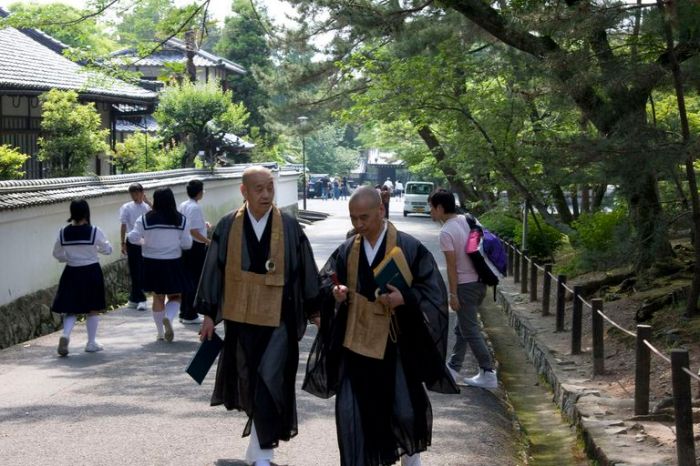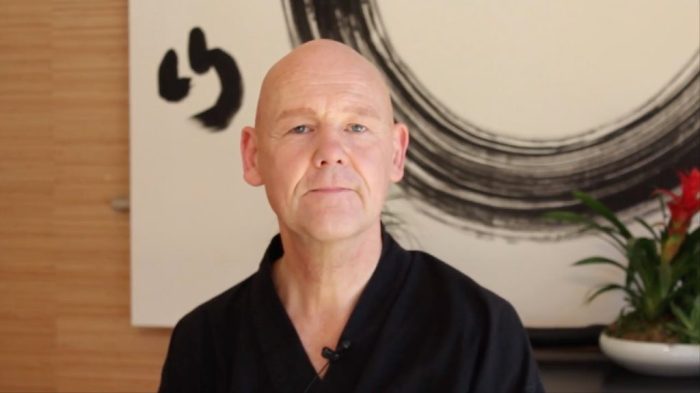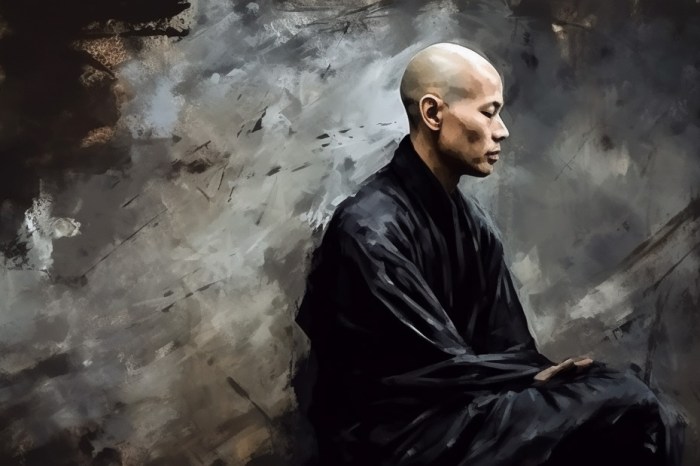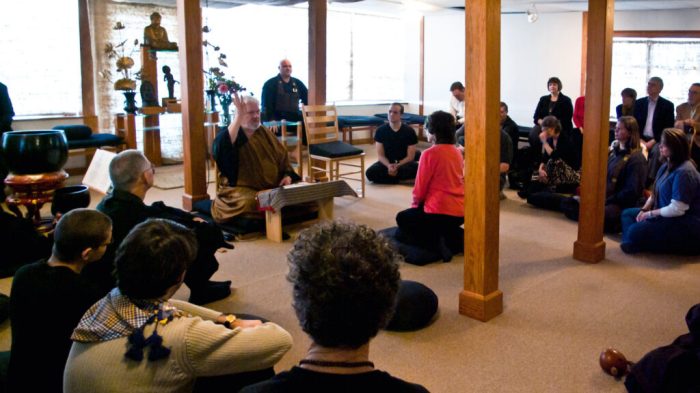Soto zen vs rinzai zen – Delve into the fascinating world of Soto Zen and Rinzai Zen, two distinct traditions of Buddhism that have shaped Japanese culture and spirituality for centuries. This comprehensive guide will unravel their historical roots, core teachings, meditation practices, and profound impact on Japanese society.
From the serene stillness of Soto Zen to the dynamic energy of Rinzai Zen, we will explore the unique approaches and practices that have guided countless practitioners toward enlightenment.
Origins and History

Soto Zen and Rinzai Zen, both influential branches of Zen Buddhism, share a common origin in China during the Tang dynasty (618-907 CE). However, they developed distinct characteristics and lineages over time.
Soto Zen
Soto Zen traces its lineage to Bodhidharma, an Indian monk who is considered the patriarch of Zen Buddhism. Bodhidharma is said to have transmitted the teachings to his disciple Huike, who in turn passed them on to the Sixth Patriarch, Huineng.
Huineng’s teachings emphasized the importance of silent meditation (zazen) as the primary means of attaining enlightenment.
Rinzai Zen
Rinzai Zen is named after the Chinese master Linji Yixuan (866-926 CE). Linji’s teachings were characterized by a more dynamic and confrontational approach to Zen practice. He used paradoxical language and koans (riddles) to challenge students and provoke sudden insights.
Core Teachings and Practices

Soto Zen and Rinzai Zen share a common foundation in Zen Buddhism, but they differ in their approaches to practice and enlightenment. Soto Zen emphasizes silent meditation, while Rinzai Zen places more emphasis on koan study and sudden enlightenment.
If you’re delving into the differences between Soto Zen and Rinzai Zen, you might also find our guide to nbme 12 answers step 2 helpful. Returning to our discussion on Zen Buddhism, the key distinction between Soto Zen and Rinzai Zen lies in their approaches to meditation.
Soto Zen Teachings
- Emphasizes the practice of shikantaza, or “just sitting.”
- Seeks enlightenment through gradual cultivation of insight and mindfulness.
- Values simplicity and everyday life as the path to enlightenment.
Rinzai Zen Teachings
- Emphasizes the use of koans, or paradoxical riddles, to provoke sudden enlightenment.
- Believes that enlightenment can be attained suddenly through a breakthrough in understanding.
- Places more emphasis on formal meditation and strict discipline.
Meditation Practices
Soto Zen practitioners engage in silent meditation, focusing on their breath and body sensations. They aim to cultivate a state of mindfulness and awareness without seeking specific results.
Rinzai Zen practitioners use various meditation techniques, including zazen(seated meditation) and kinhin(walking meditation). They also engage in koan study, which involves contemplating paradoxical riddles to challenge their understanding and provoke sudden enlightenment.
Enlightenment and Daily Life
Soto Zen views enlightenment as a gradual process that unfolds through daily practice and mindfulness. Practitioners strive to integrate their spiritual insights into their everyday lives, cultivating compassion and wisdom in all their actions.
Rinzai Zen places more emphasis on the sudden attainment of enlightenment. Practitioners seek to break through their preconceptions and experience a profound shift in consciousness. They believe that enlightenment transforms all aspects of life, leading to a state of freedom and spontaneity.
Differences in Meditation Techniques

Soto Zen and Rinzai Zen differ in their meditation techniques. These techniques vary in terms of posture, focus, and duration.
Posture
In Soto Zen, practitioners sit in a cross-legged position with their spine straight and their hands resting on their thighs. In Rinzai Zen, practitioners sit in a kneeling position with their back straight and their hands placed in a specific mudra (hand gesture).
Focus
Soto Zen emphasizes silent meditation, known as shikantaza, where practitioners focus on their breath and the present moment. Rinzai Zen employs various meditation techniques, including koan study and zazen, where practitioners concentrate on a paradoxical riddle or engage in mindful sitting.
Duration
Soto Zen sessions typically last for longer periods, ranging from 20 minutes to several hours. Rinzai Zen sessions are shorter, usually around 10-15 minutes, but may be repeated several times throughout the day.
Role of the Master and Student

In both Soto Zen and Rinzai Zen, the master-student relationship is central to the transmission of teachings and spiritual development.
So, when we talk about Soto Zen vs Rinzai Zen, we’re really getting into the nitty-gritty of Zen Buddhism. But if you’re looking for a more practical application of Zen principles, I highly recommend checking out the omega psi phi msp test . It’s a great way to assess your strengths and weaknesses in terms of leadership and interpersonal skills.
And hey, who knows? You might just learn a thing or two about Soto Zen and Rinzai Zen along the way.
In Soto Zen, the master is a guide who provides instruction and support to students as they progress on their spiritual path. The master’s role is to help students understand the teachings of the Buddha and to develop the qualities of wisdom, compassion, and liberation.
Master’s Role in Soto Zen
- Provides instruction and guidance on the teachings of the Buddha.
- Offers support and encouragement to students on their spiritual journey.
- Conducts formal interviews (dokusan) to help students deepen their understanding of the teachings.
- Transmits the lineage of Soto Zen through ordination and dharma transmission.
In Rinzai Zen, the master is a more active participant in the student’s spiritual development. The master may use a variety of techniques, such as koans, to challenge students and help them break through their limitations.
Master’s Role in Rinzai Zen, Soto zen vs rinzai zen
- Presents koans to students to stimulate their thinking and break through conceptual limitations.
- Uses sharp questioning and shouts to challenge students and provoke sudden awakenings.
- Conducts formal interviews (sanzen) to guide students and provide feedback on their progress.
- Transmits the lineage of Rinzai Zen through ordination and dharma transmission.
The master-student relationship in both Soto Zen and Rinzai Zen is a dynamic and evolving one. As the student progresses on their spiritual path, the relationship may change and adapt to meet their changing needs.
Impact on Japanese Culture

Soto Zen and Rinzai Zen have had a profound impact on Japanese culture, shaping its art, literature, and philosophy. These Zen schools emphasize the importance of mindfulness, meditation, and self-discipline, values that have become deeply ingrained in Japanese society.
Art
Zen aesthetics have influenced Japanese art forms such as calligraphy, painting, and tea ceremony. The concept of “wabi-sabi,” which embraces simplicity, asymmetry, and the beauty of imperfection, is rooted in Zen teachings. Zen gardens, with their carefully placed rocks and raked gravel, are designed to evoke a sense of tranquility and mindfulness.
Literature
Zen principles have also shaped Japanese literature, particularly haiku poetry and the works of Zen masters. Haiku, with its focus on brevity, nature, and the present moment, reflects the Zen emphasis on simplicity and the interconnectedness of all things. Zen masters such as Dogen and Hakuin wrote extensively on Zen teachings, their works becoming influential in both religious and secular spheres.
Philosophy
Zen Buddhism has influenced Japanese philosophy, particularly the development of Bushido, the code of conduct for samurai warriors. Bushido emphasizes loyalty, courage, and self-sacrifice, values that resonate with the Zen principles of discipline and self-mastery. Zen teachings have also influenced Japanese management practices, with the emphasis on mindfulness and attention to detail.
Soto Zen and Rinzai Zen, two major schools of Zen Buddhism, emphasize different approaches to enlightenment. Soto Zen focuses on seated meditation, while Rinzai Zen uses koans and physical techniques to awaken students. Interestingly, the pass rate for the New York State School Business Leader (SBL) exam has been a topic of discussion among aspiring school business leaders.
Click here to learn more about the NYS SBL exam pass rate. Returning to our discussion, Soto Zen and Rinzai Zen continue to offer unique paths to spiritual growth and enlightenment.
Modern Interpretations and Applications: Soto Zen Vs Rinzai Zen

In the modern era, Soto Zen and Rinzai Zen have undergone significant transformations to adapt to changing cultural and societal landscapes. They have also found widespread acceptance and application in the West, where they have influenced various aspects of contemporary life.
Contemporary interpretations of Soto Zen and Rinzai Zen emphasize the practical application of their teachings in daily life. Practitioners seek to integrate the principles of mindfulness, compassion, and wisdom into their personal and professional lives. This has led to the development of mindfulness-based programs and practices that are widely used in healthcare, education, and the corporate world.
Soto Zen in the Modern World
- Soto Zen has gained popularity in the West as a means of cultivating mindfulness and reducing stress.
- Soto Zen practitioners engage in zazen meditation, which involves sitting in a quiet and still position, focusing on the breath or a koan (a paradoxical riddle).
- Soto Zen emphasizes the importance of everyday activities as opportunities for practice, known as “ordinary mind” or “beginner’s mind.”
Rinzai Zen in the Modern World
- Rinzai Zen has also found a following in the West, particularly among those seeking a more rigorous and challenging path.
- Rinzai Zen practitioners engage in koan study and intensive meditation retreats, often under the guidance of a master.
- Rinzai Zen emphasizes the importance of “sudden enlightenment,” which is believed to be a transformative experience that leads to a deep understanding of the nature of reality.
Essential FAQs
What is the key difference between Soto Zen and Rinzai Zen?
Soto Zen emphasizes silent meditation (zazen) as the primary path to enlightenment, while Rinzai Zen places greater emphasis on koan study and sudden awakening.
How do the meditation techniques of Soto Zen and Rinzai Zen differ?
Soto Zen practitioners typically sit in a still and upright posture, focusing on their breath or a koan. Rinzai Zen practitioners may use a variety of postures and techniques, including dynamic breathing and chanting.
What is the role of the master in Soto Zen and Rinzai Zen?
In both traditions, the master plays a crucial role in guiding students along the path to enlightenment. Soto Zen masters often emphasize the importance of self-reliance and introspection, while Rinzai Zen masters may use more direct and challenging methods.